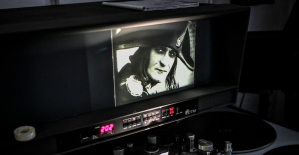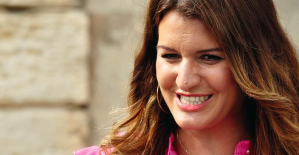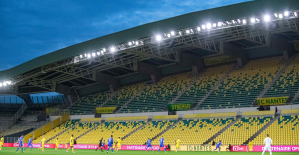A gentle jolt pulls the still sleeping guests of the Costa Verde Express out of their dreams. The train leaves the small train station in Viveiro at walking pace. Early morning fog lies over the Galician coastal town in the extreme north-west of Spain.
The sparkling Albariño white wine served with crawfish and octopus arms at dinner in the dining car keeps most dozing off a bit longer. The onset of the rhythmic rattling of the train does not make getting up any easier. But in the corridor, the train crew is already ringing a bell: breakfast.
The scent of warm croissants, fresh coffee, Ibérico ham and scrambled eggs fills the air in the dining car. A stewardess in a white uniform invites you to an empty table with cloth serviettes, fresh flowers and a lamp with a yellow marbled glass shade. Reading the newspaper while having breakfast is not easy. Again and again the passing coastal landscape tempts you to look out the window.
Long sandy beaches alternate with rugged cliffs. In between, the journey goes through dense forests, past old fishing villages. At a leisurely 50 kilometers per hour, the Costa Verde Express travels just a few meters past the Cantabrian Sea. These are old narrow-gauge tracks. In parts, they run parallel to the northern Way of St. James Coast, the Camino del Norte.
While the pilgrims have to struggle on foot along the Costa Verde, the "Green Coast", Julio Cesar Pallucchini and his wife Liliana sit in the wood-panelled, carpeted lounge of the Costa Verde Express and enjoy the landscape in feel-good mode with a café con leche.
"Thank God the train only partially lives up to its name," says Julio. The Costa Verde is really impressive green. On the other hand, says Julio, he's happy that it's not an express train, but rather a tourist train. So you can observe the landscape in peace. He was looking for exactly this type of decelerating travel. "And of course the good food," he says and laughs.
The train journey takes you through the Basque Country, Cantabria, Asturias and Galicia: Spain's gastronomic strongholds par excellence, as Laura López puts it. She is Executive Chef on board the Costa Verde Express. Food also plays a special role on this train journey.
While they dine in restaurants on the daily excursions, Laura and her colleague Daniela prepare delicacies from the region where the train is stopping in the evening. Scallops and octopus in Galicia, wild salmon, fabada stew and Cabrales cheese in Asturias, Cocido Montañes stew in Cantabria, cod in the Basque Country.
The Costa Verde Express is one of the so-called historical royal trains of the state railway company Renfe. They are something like Spanish Orient Express versions, reminiscent of train journeys from a previous century.
The nostalgic train in Belle Époque style takes six days to cover the approximately 600 kilometers between Bilbao in the Basque Country and the Galician pilgrimage site of Santiago de Compostela. Depending on the date, it goes in one direction or the other.
This time the train adventure started at the tomb of Saint James the Apostle in Santiago de Compostela. Above the tomb stands the cathedral, which is the destination of the Way of St. James.
Train passenger Julio Cesar Pallucchini is looking forward to Galicia's second most famous cathedral. Near Ribadeo, the bus that accompanies the Costa Verde Express for the daily excursions takes passengers to the "Beach of the Cathedrals". The tides created a truly spectacular cliff whose imposing rock gates are reminiscent of flying buttresses in Gothic cathedrals.
Julio and his wife Liliana get lost in the bizarre rock formations, tunnels and caves that are repeatedly interrupted by long stretches of beach. "Nature is the best master builder," says the Argentine contractor.
The train also makes a stop in Oviedo on its journey. The first Way of St. James starts from the cathedral of the city. Asturias King Alfonso II is said to have ridden from Oviedo as the first pilgrim to Galicia after the discovery of the apostle's tomb in 812.
Guide Noelia López shows the Plaza del Fontán with its numerous bars and restaurants near the cathedral. Of course she orders a bottle of cider and shows the guests how to pour the sparkling cider into the glass from high up.
Sidra is Asturias national drink. This becomes clear the next day on the bus ride to the Picos de Europa National Park, which takes you past countless apple orchards - this is where the fruit for the cider comes from.
In Cangas de Onís, on the medieval bridge over the River Sella, there is a copy of the cross that Asturias' first king, Pelayo, is said to have carried to the Battle of Covadonga in 722. This was the beginning of the Reconquista, the Christian reconquest of the Iberian Peninsula from the Moors.
A narrow mountain road leads up to the pilgrimage site of Covadonga, where Don Pelayo is buried. Even further up, at more than 1000 meters, are the mountain lakes Enol and Ercina, embedded in an almost kitschy green postcard mountain landscape. The short hike and the mountain air whet your appetite.
In the star restaurant "El Corral del Indianu" in Arriondas, chocolates with Cabrales cheese and white chocolate and a gourmet version of the hearty Asturian fabada stew are already waiting.
In the afternoon, after a brief visit to the fishing village of Llanes, continue by train to Cabezón de la Sal in Cantabria. As every evening, the train stops at the station so that the passengers can sleep. Cool country air flows through the sliding window, crickets chirp.
The next morning it becomes clear to everyone why Spain's north is so green: it's raining cats and dogs. On the platform, the train staff hands out umbrellas for the excursion. The bus takes half an hour to get to Altamira Cave, often referred to as the Stone Age Sistine Chapel.
The prehistoric cave paintings of bison, deer and horses are a good 14,000 years old. Today, only a small number of lucky people drawn by lot can visit the original cave, wearing protective suits and breathing masks. But the difference to the cave replica next door is hardly noticeable.
Lunch is available two kilometers further in Santillana del Mar. The stone houses are adorned with coats of arms and wooden balconies decorated with flowers. The Convent of the Clarisse Colegiata de Santa Juliana is one of the most important Romanesque sacred buildings in Cantabria.
Cantabria's elegant capital, Santander, with its magnificent Art Nouveau buildings, seems downright young in comparison. A few years ago, the silver-scaled Centro Botín opened here. Built directly on the river promenade, the magnificent building of the Botín banking family, owners of Bank Santander, offers the most modern avant-garde art.
But the Centro Botín cannot compete with the world-famous Guggenheim Museum in the Basque coastal metropolis of Bilbao. The futuristic building designed by the American star architect Frank O. Gehry is one of the most popular museums in Spain.
Almost a million visitors come to Bilbao every year to see the Guggenheim. Formed from silver titanium plates, the building on the Nervión looks like a gigantic serviette and can be seen from afar from the Costa Verde Express. The view also announces the end of the journey. Bilbao is the train's destination station.
How to get there: Depending on where the train departs from, you have to fly to Bilbao or Santiago de Compostela.
Journey on the Costa Verde Express: The classic journey on the Costa Verde Express between Bilbao and Santiago de Compostela takes six days (five nights). There is also a shorter four-day (three-night) option that goes from Santiago de Compostela to Oviedo or vice versa. The train has a dining car, a lounge compartment and 26 suites with private bathrooms. It has space for 52 people.
Travel time and costs: The season runs from mid-May to the end of October, the six-day trip costs 4,000 euros per person. The short trips cost 1800 euros per person.
Further information: Information and booking of the luxury tourist trains at Renfe: renfe.com/es/es; Costa Verde Express: renfe.com/es/en/experiences/luxury-journeys/costa-verde-express/the-train
1 of 13
2 out of 13
3 out of 13
4 out of 13
5 out of 13
6 out of 13
7 out of 13
8 out of 13
9 out of 13
10 out of 13
11 out of 13
12 out of 13
13 of 13

 Iran-Israel conflict: what we know about the events of the night after the explosions in Isfahan
Iran-Israel conflict: what we know about the events of the night after the explosions in Isfahan Sydney: Assyrian bishop stabbed, conservative TikToker outspoken on Islam
Sydney: Assyrian bishop stabbed, conservative TikToker outspoken on Islam Torrential rains in Dubai: “The event is so intense that we cannot find analogues in our databases”
Torrential rains in Dubai: “The event is so intense that we cannot find analogues in our databases” Rishi Sunak wants a tobacco-free UK
Rishi Sunak wants a tobacco-free UK Alert on the return of whooping cough, a dangerous respiratory infection for babies
Alert on the return of whooping cough, a dangerous respiratory infection for babies Can relaxation, sophrology and meditation help with insomnia?
Can relaxation, sophrology and meditation help with insomnia? WHO concerned about spread of H5N1 avian flu to new species, including humans
WHO concerned about spread of H5N1 avian flu to new species, including humans New generation mosquito nets prove much more effective against malaria
New generation mosquito nets prove much more effective against malaria The A13 motorway closed in both directions for an “indefinite period” between Paris and Normandy
The A13 motorway closed in both directions for an “indefinite period” between Paris and Normandy The commitment to reduce taxes of 2 billion euros for households “will be kept”, assures Gabriel Attal
The commitment to reduce taxes of 2 billion euros for households “will be kept”, assures Gabriel Attal Unemployment insurance: Gabriel Attal leans more towards a tightening of affiliation conditions
Unemployment insurance: Gabriel Attal leans more towards a tightening of affiliation conditions “Shrinkflation”: soon posters on shelves to alert consumers
“Shrinkflation”: soon posters on shelves to alert consumers The restored first part of Abel Gance's Napoléon presented at Cannes Classics
The restored first part of Abel Gance's Napoléon presented at Cannes Classics Sting and Deep Purple once again on the bill at the next Montreux Jazz Festival
Sting and Deep Purple once again on the bill at the next Montreux Jazz Festival Rachida Dati: one hundred days of Culture on the credo of anti-elitism
Rachida Dati: one hundred days of Culture on the credo of anti-elitism The unbearable wait for Marlène Schiappa’s next masterpiece
The unbearable wait for Marlène Schiappa’s next masterpiece Skoda Kodiaq 2024: a 'beast' plug-in hybrid SUV
Skoda Kodiaq 2024: a 'beast' plug-in hybrid SUV Tesla launches a new Model Y with 600 km of autonomy at a "more accessible price"
Tesla launches a new Model Y with 600 km of autonomy at a "more accessible price" The 10 best-selling cars in March 2024 in Spain: sales fall due to Easter
The 10 best-selling cars in March 2024 in Spain: sales fall due to Easter A private jet company buys more than 100 flying cars
A private jet company buys more than 100 flying cars This is how housing prices have changed in Spain in the last decade
This is how housing prices have changed in Spain in the last decade The home mortgage firm drops 10% in January and interest soars to 3.46%
The home mortgage firm drops 10% in January and interest soars to 3.46% The jewel of the Rocío de Nagüeles urbanization: a dream villa in Marbella
The jewel of the Rocío de Nagüeles urbanization: a dream villa in Marbella Rental prices grow by 7.3% in February: where does it go up and where does it go down?
Rental prices grow by 7.3% in February: where does it go up and where does it go down? With the promise of a “real burst of authority”, Gabriel Attal provokes the ire of the opposition
With the promise of a “real burst of authority”, Gabriel Attal provokes the ire of the opposition Europeans: the schedule of debates to follow between now and June 9
Europeans: the schedule of debates to follow between now and June 9 Europeans: “In France, there is a left and there is a right,” assures Bellamy
Europeans: “In France, there is a left and there is a right,” assures Bellamy During the night of the economy, the right points out the budgetary flaws of the macronie
During the night of the economy, the right points out the budgetary flaws of the macronie These French cities that will boycott the World Cup in Qatar
These French cities that will boycott the World Cup in Qatar Champions League: France out of the race for 5th qualifying place
Champions League: France out of the race for 5th qualifying place Ligue 1: at what time and on which channel to watch Nantes-Rennes?
Ligue 1: at what time and on which channel to watch Nantes-Rennes? Marseille-Benfica: 2.99 million viewers watching OM’s victory on M6
Marseille-Benfica: 2.99 million viewers watching OM’s victory on M6 Cycling: Cofidis continues its professional adventure until 2028
Cycling: Cofidis continues its professional adventure until 2028


















